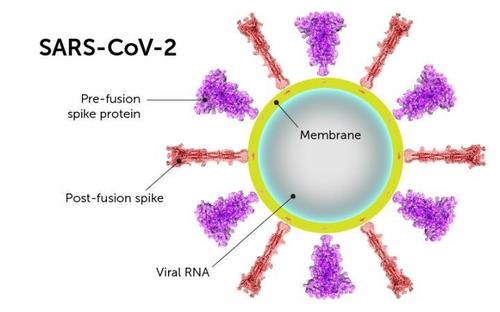UK Cambridge University researchers unveil similar cases of’mutation from UK’
Recovery plasma treatment, possibility of encouraging mutation… Journal’Nature’ paper

The novel coronavirus’ Spike protein has been reported to continue to modify after binding to the host cell’s ACE2 receptor.
Image of spike protein with some bumps changed in the form of folded hairpins.
[미 보스턴 아동병원 천 빙 박사팀 ‘사이언스’ 논문 캡처 / 재판매 및 DB 금지]
(Seoul = Yonhap News) Reporter Ki-cheon Han = Research results show that a mutation of the novel coronavirus similar to the’mutation from the UK’ is highly likely to occur in patients with chronic Corona 19 (new coronavirus infection).
The longer the treatment period for patients with Corona 19 increases the chance for the virus to evolve like this.
Scientists have identified this type of mutation in virus samples from immune-compromised COVID-19 patients who have undergone plasma treatment of recovering patients and submitted a related paper to the journal Nature on the 5th (local time).
The study was conducted by the COG-UK (COVID-19 Genomics UK) consortium led by the University of Cambridge, UK.
In experiments with the synthetic Spike protein (synthetic version), the research team confirmed that changes in the specific genetic code (RNA) observed in the’English mutation’ (B1.1.7) doubled the virus’s cellular infectivity.
The RNA of the new coronavirus (SARS-CoV-2), a beta coronavirus family, consists of four bases (nucleotides) sequences A, C, G, U.
When virus particles are replicated, mutations are the result of mistranslation of this code.
Coronavirus changes approximately 23 nucleotides a year, so the mutation rate is not high.
Of particular concern to scientists is the mutation that causes changes in the structure of the spike protein on the surface of the novel corona.
The novel corona binds to the ACE2 receptor on the surface of the host cell to open the cell infiltrate, and the spike protein plays a key role in this process.
In other words, disabling the function of the Spike protein could prevent new corona infections.
This is why most vaccines currently vaccinated or under test target Spike proteins.
The problem is that if the structure of the spike protein changes due to mutation, the effectiveness of the difficultly developed vaccine may be reduced.

Graphic showing the process of fusion of the outer membrane of the viral particle with the host cell membrane after the spike protein binds to the ACE2 receptor.
It is a computer graphic reconstructed based on the contents of a paper in the journal’Science’.
[미 보스턴 아동병원 Jonathan Khao 박사 등 제공 / 재판매 및 DB 금지]
The mutant novel corona, which was confirmed to have doubled its infectivity this time, contained a specific amino acid (ΔH69/ΔV70) of the spike protein.
The research team described in a paper the process of this mutation, citing a case of a corona19 death patient who was admitted to the Aden Brooks Hospital in Cambridge.
This patient in their 70s was diagnosed with B-cell lymphoma prior to infection with Corona 19, and had weakened immunity after several chemotherapy.
In this condition, the patient was hospitalized again for Corona 19 and received remdesivir (antiviral) and recovery plasma treatment. This plasma contains antibodies isolated from the blood of patients recovering from COVID-19.
The patient, who was initially stable, gradually worsened and died after receiving intensive care in the emergency room.
While the patient was hospitalized, the researchers took 23 samples of the virus from the nose and throat and analyzed the gene sequence.
However, after two doses of recovery plasma (between the 66th and 82nd days of hospitalization), a radical change in the viral composition occurred.
A mutant virus in which the ΔH69/ΔV70 amino acids were deleted along with the Spike protein mutation known as D796H dominated the whole.
The mutant virus, which initially seemed to die off, began to rapidly increase particles when the third treatment was initiated, in which remdesivir and recovery plasma were administered together.

[MIT Markus Buehler & Yiwen Hu 제공 / 재판매 및 DB 금지]
“What we’ve seen is a fierce competition between different mutant viruses,” said Ravi Gupta, a professor at Cambridge University’s “Therapeutic Immune Infectious Disease Research Institute,” who led the study.
The final winner, the mutant virus, which is a combination of the D796H mutation and the ΔH69/ΔV70 deletion, dominated during plasma treatment, but was once caught up by another species, and re-emerged as third plasma treatment resumed.
In a strictly controlled environment, three synthetic viruses with both mutations or one each were tested and tested. As a result, the virus with both mutations at the same time tolerated the neutralizing action of recovered plasma.
Of particular note is that only viruses with the D796H mutation lose their infectivity when plasma is not administered.
This is a typical mutation the virus acquires to avoid when the immune system is pressed, scientists explain.
Scientists estimate that the increase in infectivity of viruses with the deletion of the ΔH69/ΔV70 amino acids may compensate for the loss of infectivity caused by the D796H mutation.
Professor Gupta said, “It is raising the worrying possibility that the novel corona may mutate and outrun the vaccine.” The possibility is also increased, so we need to pay special attention.”
Unauthorized reproduction-redistribution prohibited>
2021/02/08 18:13 sent
